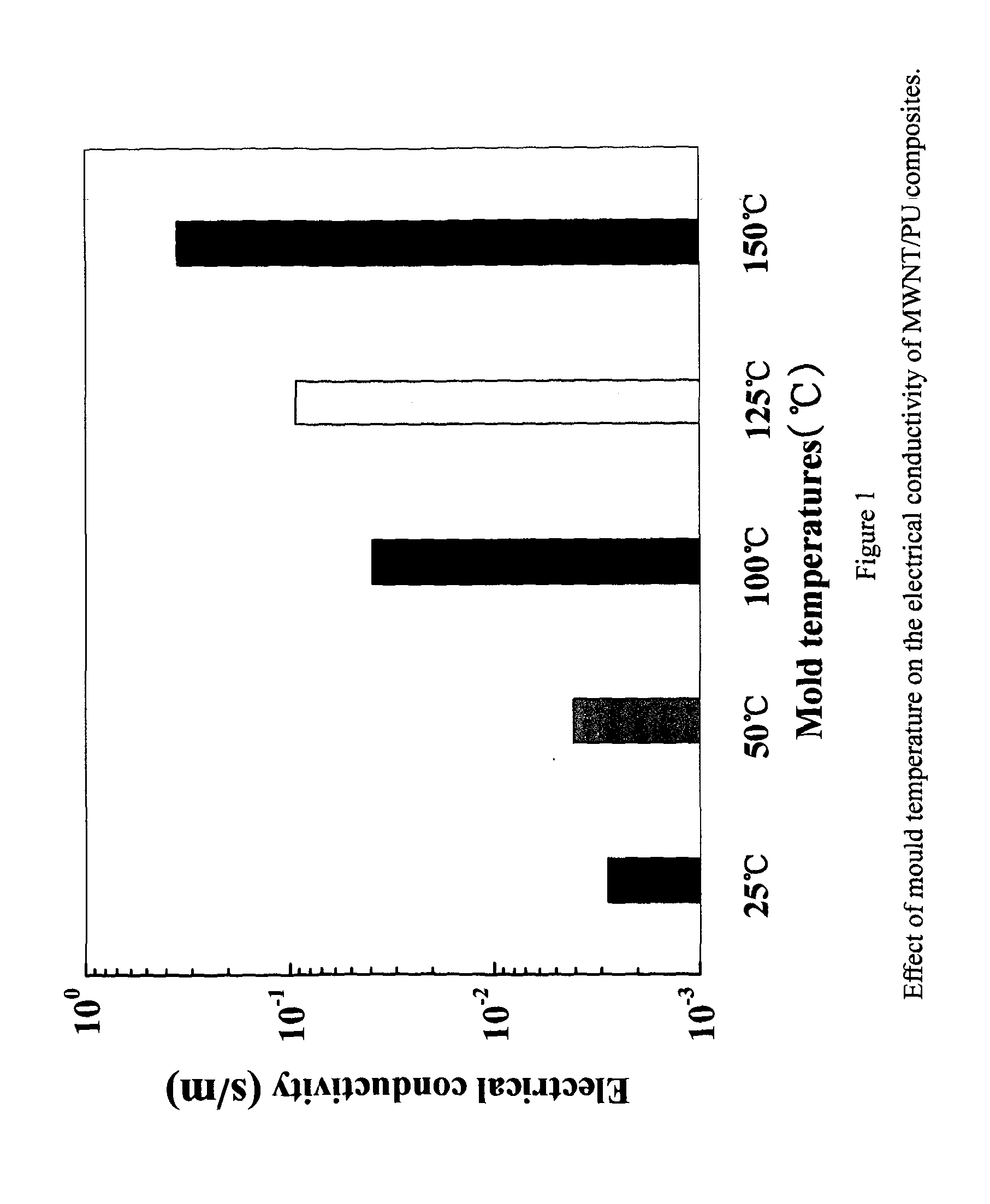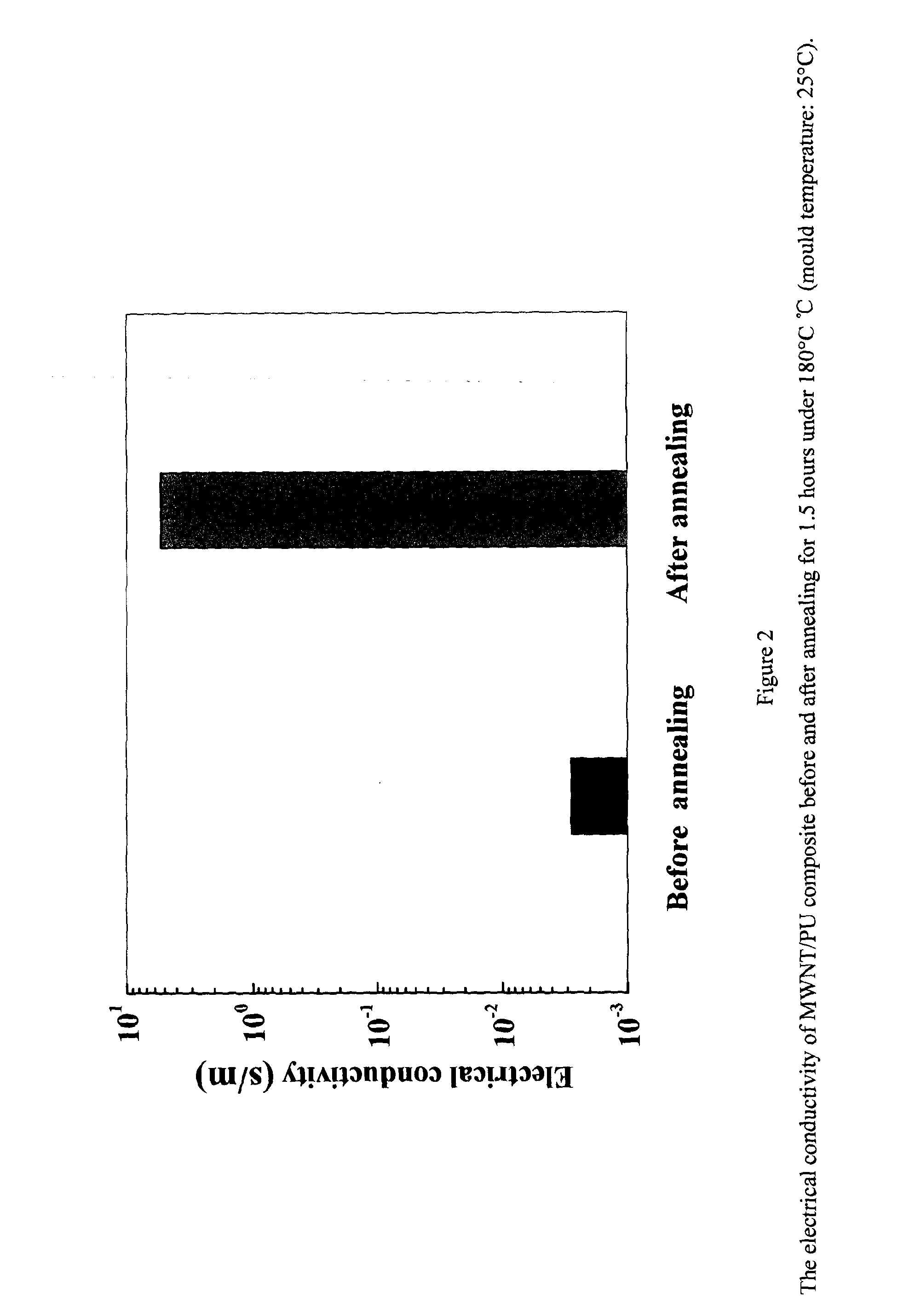Methods to Improve the Electrical Conductivity for Moulded Plastic Parts
a technology of plastic parts and electrical conductivity, which is applied in the field of polymer processing, can solve the problems of difficult to obtain good electrical conductivity, difficult to meet the moulding requirements of complex and high-precision micro-parts, and significant differences in electrical conductivity at different locations in moulded parts, so as to improve electrical conductivity and high strain rate and stress.
- Summary
- Abstract
- Description
- Claims
- Application Information
AI Technical Summary
Benefits of technology
Problems solved by technology
Method used
Image
Examples
example 1
[0032](1) Multi-walled Carbon Nanotube (MWNT)
[0033]MWNT (Product number: C7000) with a diameter of 15 nm, product of Nanocyl, Belgium was used.
[0034](2) Thermoplastic polyurethane elastomer (PU)
[0035]PU (Product number: ESA-480) with shore hardness 80A, product of Shenzhen Pepson Company, China was used.
[0036]Firstly, 30 g MWNT and 270 g dried pelletized PU were firstly well mixed and then blended in a twin-screw extruder (L / D: 36, model: SHJ-25, Nanjing ChengMeng Plastics Machinery Industry Company, Ltd, China) in the range of 185-195° C. and a screw speed of 120 rpm. The extrudate was quenched in a water bath, cut into pellets and then dried in a vacuum oven at 100° C. for 8 h. The MWNT / PU masterbatch with 10 wt % MWNT were prepared.
[0037]Secondly, 200 g of pellets of this master batch and 200 g PU were blended in the twin-screw extruder again under the same processing conditions as the first step. The extrudate was quenched in a water bath, cut into pellets, and dried in a vacuum...
example 2
[0041]MWNT / PU composites were prepared as the same process in Example 1. The composites were micro injection moulded through a HAAKE MiniJet machine. The micro injection moulding process was conducted at a cylinder temperature of 210° C., an injection time of 10 s, an injection pressure of 77 MPa, a holding pressure of 20 MPa, a holding time of 10 seconds and a mould temperature of 25° C., The post thermal treatment was as follows: the micro injection moulded plastic parts were subject to thermal annealing treatment for 1.5 hours at 180° C. in an electric resistive heating oven. The electrical conductivity of micromoulded plastic parts is about 5.4 S. m−1. FIG. 2 shows the electrical conductivity of MWNT / PU composites before and after annealing for 1.5 hours under 180° C. The electrical conductivity of the MWNT / PU composite increased from 0.0028 s / m to 5.3597 s / m after annealing for 1.5 hours under 180° C.
example 3
[0042]15 g MWNT, 2 g diphenylamine, tristearin 2 g and 270 g high density polyethylene (HDPE, SH800, China petroleum & chemical corporation) with a melt flow index of 8.0 g / 10 min were firstly mixed and then blended in a twin-screw extruder in the temperature range of 185-195° C. and a screw speed of 120 rpm. The extrudate was quenched in a water bath, cut into pellets and then dried in a vacuum oven at 100° C. for 2 h. Then the pellets were micro injection moulded through a HAAKE MiniJet machine at a cylinder temperature of 210° C., an injection time of 10 s, an injection pressure of 77 MPa, a holding pressure of 20 Mpa, a holding time of 10 seconds and a mould temperatures of 25° C. The post thermal treatment was as follows: the micro injection moulded plastic parts were subject to thermal annealing treatment for 1.5 hours at 180° C. in an electric resistive heating oven. The electrical conductivity of the micro injection moulded MWNT / HDPE sample is ˜30S. m−1.
PUM
| Property | Measurement | Unit |
|---|---|---|
| Temperature | aaaaa | aaaaa |
| Diameter | aaaaa | aaaaa |
| Diameter | aaaaa | aaaaa |
Abstract
Description
Claims
Application Information
 Login to View More
Login to View More - R&D
- Intellectual Property
- Life Sciences
- Materials
- Tech Scout
- Unparalleled Data Quality
- Higher Quality Content
- 60% Fewer Hallucinations
Browse by: Latest US Patents, China's latest patents, Technical Efficacy Thesaurus, Application Domain, Technology Topic, Popular Technical Reports.
© 2025 PatSnap. All rights reserved.Legal|Privacy policy|Modern Slavery Act Transparency Statement|Sitemap|About US| Contact US: help@patsnap.com



